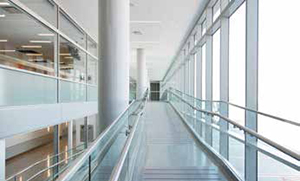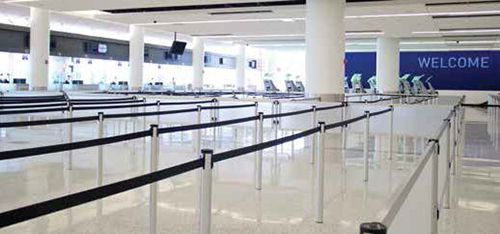JetBlue Extension at Kennedy Int'l Includes the Unexpected

The 150,000-square-foot extension of Terminal 5 at John F. Kennedy International Airport has JetBlue Airways all over it - literally and figuratively.
 From a visual standpoint, the recent $200 million addition known as T5i ("i" for international) was designed to be a natural extension to the gateway originally opened in 2008. "JetBlue has been very, very focused on keeping a consistent theme and consistent finishes throughout T5," says Mark Ahasic, JetBlue alum-turned-Arup senior airport planner. "What is different is the customer experience."
From a visual standpoint, the recent $200 million addition known as T5i ("i" for international) was designed to be a natural extension to the gateway originally opened in 2008. "JetBlue has been very, very focused on keeping a consistent theme and consistent finishes throughout T5," says Mark Ahasic, JetBlue alum-turned-Arup senior airport planner. "What is different is the customer experience."
| factsfigures Project: Terminal Expansion Location: John F. Kennedy Int'l Airport Terminal: 5 Owner/Terminal Operator: JetBlue Airways Corp. Governing Body: Port Authority of NY and NJ Expansion Footprint: 150,000 sq. ft. Major Elements: 3 new gates; int'l arrivals facility; additional concessions Passenger Amenities: Children's play area with interactive faux cockpit, flight simulator & control tower; open-air park for pets & passengers Design Components: Shorter walking distances from aircraft to Customs & Baggage Claim; brighter walkways & int'l arrivals processing area Construction Services: Turner Construction Architect: Gensler Planner & Engineer of Record: Arup Automated Passport Control Kiosks: SITA Seating: Thonet Crowd Control Stanchions: Visiontron Visitor Welcome Center: Parabit Children's Play Area: Lee H. Skolnick Architecture + Design Partnership; Gensler Project's Est. Economic Impact: 1,090 jobs created (including construction); $74 million wages generated; $325 million in total economic activity |
In addition to uniting the airline's international and domestic operations into a single facility, JetBlue is adding new amenities for customers of all ages (and even breeds). Digital welcome centers are already in place and an interactive children's play area and separate rooftop park for pets and passengers alike are set to open this spring.
Between subtleties like sunlit corridors to additional food and retail concessions, JetBlue is pulling out all the stops in the latest iteration of its bustling JFK facility.
Ahasic, who recently celebrated four years of service with Arup after working six years as JetBlue's director of operational planning, effortlessly puts on his JetBlue hat when speaking about his former employer's operating principles.
"JetBlue is all about what they call the 'JetBlue experience' and really trying to deliver a great product and service to their customer," he explains. "The design and the planning of this terminal has always had that in mind."
The T5i expansion centers around the airline's new international arrivals facility and includes a total of six contact gates that can handle international arrivals, plus three bus hardstand positions.
From concessions to contact gates, the expansion was designed to strictly adhere to JetBlue's Customer Bill of Rights, which stresses "bringing humanity back to air travel" and making every part of the experience "as simple and as pleasant as possible."
"We have been working with JetBlue for 10 years now, and their ethos is all we have been," says Gensler's director of Aviation and Transportation, Ty Osbaugh. "If another airline does it in way X, they will do it in way Y."
 In a mathematical interpretation of Osbaugh's reference, JetBlue's approach to the passenger experience is very vertical, or Y-axis, in nature.
In a mathematical interpretation of Osbaugh's reference, JetBlue's approach to the passenger experience is very vertical, or Y-axis, in nature.
"Everything that JetBlue does is predicated on the notion of bettering customer service by changing the paradigm of what you would normally expect," Osbaugh explains. "Gensler would like to work, as well, in terms of always doing a little bit of the unexpected and finding our architectural moments when people are really not expecting them."
Bright & Tight
T5i, which is located on the former site of the Terminal 6 Sundrome, is essentially an international arrivals facility that happens to have three additional gates added to the building. With that in mind, JetBlue and Gensler set their sights on improving its Customs and Border Protection (CBP) processes.
"There is a a fairly prescriptive formula on how you arrive at the design for (CBP facilities), as they are very regulated in terms of spaces and overall look and feel," Osbaugh relates. "But for Gensler and JetBlue, the spaces in between those events were where we could really add to the customer experience."
Osbaugh cites the fixed-length space that takes arriving passengers from the aircraft into the sterile corridor as an area where the design mission has been particularly successful. Basically, it's a glass box; so deplaning customers unexpectedly see sunlight as opposed to a dark, convoluted arrival corridor, as in many airports.
"People are getting a little bit confused - in a good way - when they get off the aircraft," Osbaugh reports. "I think that's probably the first place where you have the unexpected, and I think that ethos is radiating throughout T5i."
Similar "architectural sleight of hand" was also used to give the primary processing area a sunlit effect, he adds.
 "We didn't necessarily want to put primary processing inside the building itself, so we slid the arrivals out from under the building a little bit," Osbaugh explains. "By pulling the building forward a little bit, we've made a glass jewel box that gets natural light into it. In some ways, that's the unexpected. From there, you'll go through the first of what we've termed 'the tunnels' where you will see a lot of vertical light fixtures to create this rhythm that bathes the space in light."
"We didn't necessarily want to put primary processing inside the building itself, so we slid the arrivals out from under the building a little bit," Osbaugh explains. "By pulling the building forward a little bit, we've made a glass jewel box that gets natural light into it. In some ways, that's the unexpected. From there, you'll go through the first of what we've termed 'the tunnels' where you will see a lot of vertical light fixtures to create this rhythm that bathes the space in light."
Beyond the ambiance leading into the CBP hall, the area's technology is also notable. A total of 40 Automated Passport Control kiosks and 10 Global Entry units populate the space to speed passenger service.
"This technology is being rolled out to a lot of existing U.S. customs halls, but T5i is really the first facility where this has been designed from the start," notes Ahasic. "(Automated Passport Control) kiosks are starting to be omnipresent, but going back two years, we did a lot of work with JetBlue - researching the technology, looking at the various vendors, and doing passenger flow simulations to figure out how much space and how many kiosks would be required - all with the goal of minimizing the amount of time that each customer would spend in that Customs Hall before they pick up their bags and leave to go home or to their hotel."
 Serviced by 80 conveyors and two inbound carousels with dual feed lines, baggage claim is also a quick process compared to other Customs halls at JFK and other airports throughout the U.S., he adds.
Serviced by 80 conveyors and two inbound carousels with dual feed lines, baggage claim is also a quick process compared to other Customs halls at JFK and other airports throughout the U.S., he adds.
"If you look at a drawing of the T5i facility, it is very compact," Ahasic details, noting that the gates are directly adjacent to the Customs Hall in a very tight, 'postage stamp' footprint. "The walking distance that a deplaning customer will take from the aircraft into the Customs Hall to the bag claim and out is very, very short. They can really get through this facility - if they use Global Entry, in five to 20 minutes. It allows customers to get off their airplane and get out to a taxi, to their loved ones, very quickly. From that standpoint, it has been a very good experience."
Amenities & Efficiencies
The new addition also puts the JetBlue spin on amenities for outbound and connecting passengers.
 "JetBlue has always been customer-friendly, and one of their big drawing cards is their ability to relate to kids," notes Osbaugh, referencing the development of a scavenger hunt-style program that begins with a packet of information and crayons children will receive when checking in for flights out of Terminal 5.
"JetBlue has always been customer-friendly, and one of their big drawing cards is their ability to relate to kids," notes Osbaugh, referencing the development of a scavenger hunt-style program that begins with a packet of information and crayons children will receive when checking in for flights out of Terminal 5.
Clues and prompts will ultimately lead them into a 700-square-foot play space that is being developed in partnership with New York-based museum designer Lee H. Skolnick Architecture + Design Partnership. According to plans, the area will offer interactive experiences via a replica JetBlue fuselage - complete with cockpit and flight simulator - and a faux control tower with audio feeds from JFK's real tower. There will also be an area where kids can escape from it all to read books.
"There is a whole gamut of different activities that are planned within the space, but the whole idea is to make the kids' experience be just as important as the adult experience within the terminal," Osbaugh explains.
Another "coming attraction" is an outdoor park targeted to open in May. Originally designed to meet Port Authority requirements for a pet relief area, the idea snowballed into a full-fledged rooftop green space for pets and humans alike.
"Initially, we were thinking we would take a couple hundred square feet for an airside pet relief area," Osbaugh relates. "Now, we are going to utilize 10,000 square feet and make a park at the airport that everybody who is flying on JetBlue can use."
The rooftop space, he notes, will include several different programmatic components: "We have areas where you just sit on the grass; there is another kids' play area that is outside. And there are going to be tables and chairs, and potentially a vendor that will come out and serve food and drinks while you are waiting for your flight."
 Future amenities aside, the T5i addition presents a myriad of positive financial and customer service elements in its current state, says JetBlue Vice President of Corporate Real Estate Richard Smyth.
Future amenities aside, the T5i addition presents a myriad of positive financial and customer service elements in its current state, says JetBlue Vice President of Corporate Real Estate Richard Smyth.
"The most important thing we did was create a state-of-the-art and comfortable space for the CBP and all their sub-agencies. They have a better place to work," says Smyth. "That translates to a better experience for our customers, and that was our objective and probably the most important goal we achieved."
Smyth also highlights the three new international gates and three hardstands at Terminal 5. "Those additional gates just give us that much more elbow room and more flexibility," he notes.
"The time savings of not having to tow, and not having to reposition aircraft, translates into one additional aircraft a gate," relates Smyth, referring to the pre-T5i days of shuffling international aircraft and passengers between non-proprietary terminals. "The time we gain by not having to reposition those aircraft translates into one additional plane; and when you think of all the flying we can do in one day from one plane, that alone is a real tangible benefit."
FREE Whitepaper
Fairbanks International Airport Baggage Transport Conveyor Enhanced With Mod Drive™ System
Airports face a host of unique industry challenges, such as meeting efficiency regulations and seeking out the best maintenance practices to reduce costs and keep operations flowing. In today’s current economic climate, any potential cost savings can go a long way.
In 2019, Alaska’s Fairbanks International Airport (FAI) sought to modernize its equipment and operations. They were dissatisfied with the performance of the gearmotors on their baggage transport conveyors and began searching for new suppliers. Regal approached FAI with a solution that could improve equipment performance and simplify maintenance, with the added benefit of energy cost savings: the Hub City® MOD Drive™ system.
This white paper discusses the hardware deployed, the test results and the annualized expectations for ROI.








